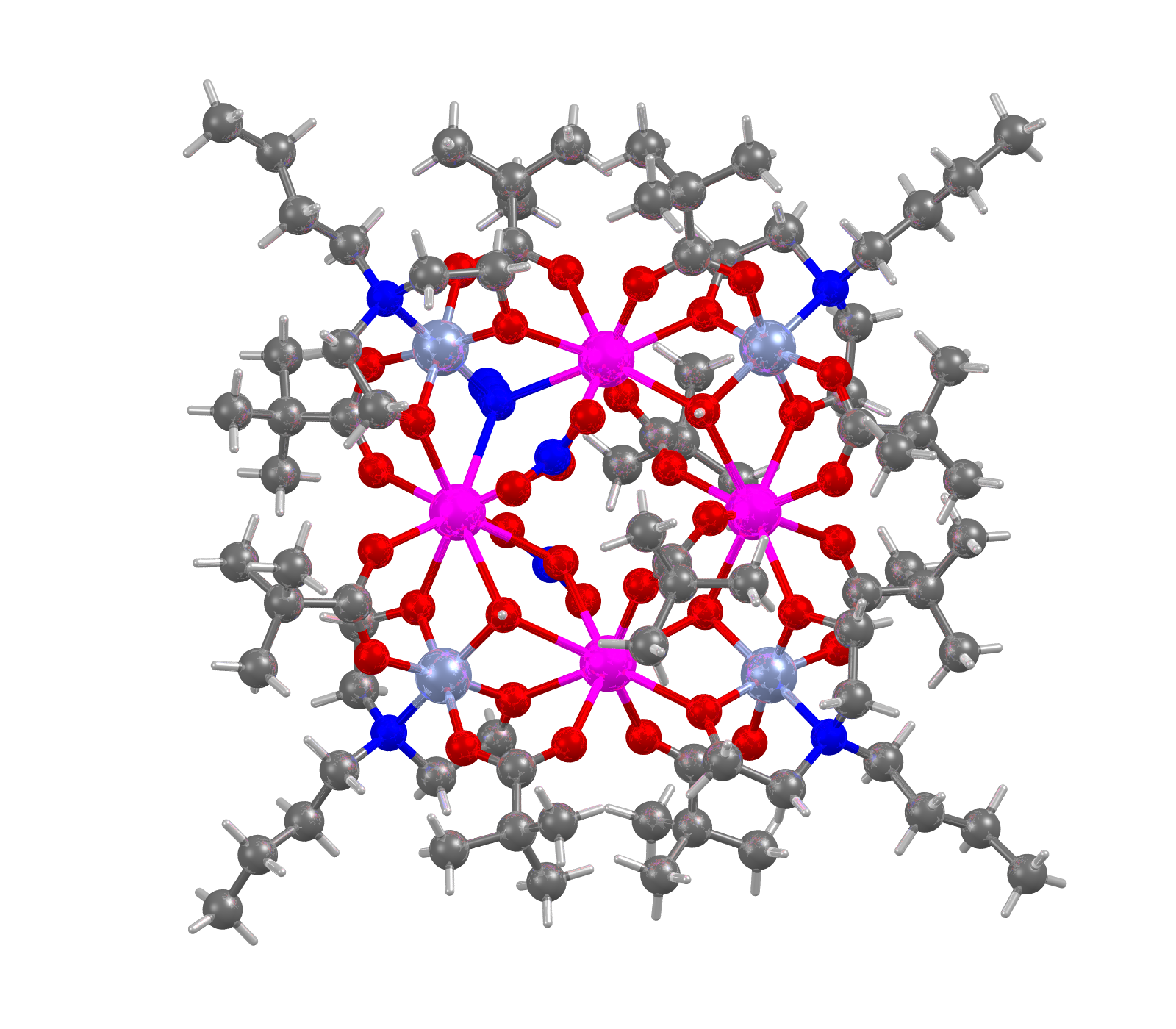Neodymium
Neodymium:
Neodymium metal, http://images-of-elements.com/ [CC BY (https://creativecommons.org/licenses/by/1.0)]
Facts about Neodymium:
- Neodymium: It is soft, silvery white metal but it quickly forms an oxide coating when exposed to air and tarnishes extremely quickly. Unlike most metals the oxide coating doesn’t protect Neodymium from further oxidisation
- Fun fact about Neodymium: This metal is abundant in the earth’s crust but it is considered a lanthanide (rare earth metal) This is because it is usually found in ores and not in its metal form.
- Chemical symbol: Nd
- Atomic number: 60
A crystal structure containing Neodymium:

Image of structure with Neodymium atoms shown as pink spheres, solvent molecules omitted for clarity
Facts about this structure:
- Formula: C82 H161 Cr4 N9 Nd4 O37,C2 H3 N,7(C H2 Cl2)
- Structure name: tetrakis(μ3-2,2′-(n-butylimino)diethanolato)-tris(μ3-hydroxo)-(μ3-azido)-decakis(μ2-pivalato)-bis(μ2-nitrato)-tetra-chromium-tetra-neodymium acetonitrile dichloromethane unknown solvate
- Fun fact about the structure: Ferromagnetic behaviour is observed.
- CSD refcode: GUHRIM (What’s this?)
- Associated publication: Annie Powell, Julia Rinck, Christopher Anson, Yanhua Lan, Inorganic Chemistry, 2015, 54, 3107, DOI: 10.1021/ic502930p
More about Neodymium:
Neodymium creates a beautiful bright pink/purple crystals. Nd:YAG (neodymium-doped yttrium aluminium garnet) is a crystal that is used in many different ways, one of which is in the military. It is the most common laser used in laser designators and laser rangefinders. I hope you’re never at the end of one of these in use. If you are, prepare yourself for a greater threat. Another use for Nd:YAG lasers are in medicine, it is used to treat skin cancers, and used for laser hair removal; industrial uses for Neodymium consists of cutting and welding steel and other metals.
Neodymium, iron and boron when formed into an alloy make the strongest permanent magnets in the world till now. Neodymium magnets look sturdy but are hard and brittle. It has a structure that resembles ceramics which is easily cracked and chipped. The discovery of this alloy allowed things to get small; especially mobile phones, microphones, loud speakers and electronic instruments. Almost all new electronic devices use Neodymium magnets in one way or another.
Neodymium is a toxic metal. Try not to get it in your eye; it will result in serious damages. Also try not to expose yourself to Neodymium dust as inhaling it causes lung embolisms (accumulation that causes blockages in blood vessels); this can also cause damage to the liver. The dust of a Neodymium magnet is extremely flammable so avoid machining or drilling into them. By chance you know someone who has a pacemaker, I plead you not to go near them with a Neodymium magnet… you can work out the rest.
Learn More About the International Year of the Periodic Table (IYPT) in Crystals Project:
This project (#IYPTCrystals) is part of the International Year of the Periodic Table celebration (#IYPT2019), read more about the project here.
You can follow us on social media; search for #IYPTCrystals or follow The CCDC on X @ccdc_cambridge on Facebook ccdc.cambridge, on Instagram ccdc_cambridge or on YouTube CCDCCambridge.
Understand some of the terms and concepts used with our Frequently Asked Questions page here.
A 3D visualization showing Neodymium in real crystal structures:
